


 NEWEST ADDITION TO THIS PAGE: ( Click on these links to jump to these other pages:)
NEWEST ADDITION TO THIS PAGE: ( Click on these links to jump to these other pages:)
 My extensively 'kit-bashed' WILD WING project: page built out on May 4th, 2006
My extensively 'kit-bashed' WILD WING project: page built out on May 4th, 2006
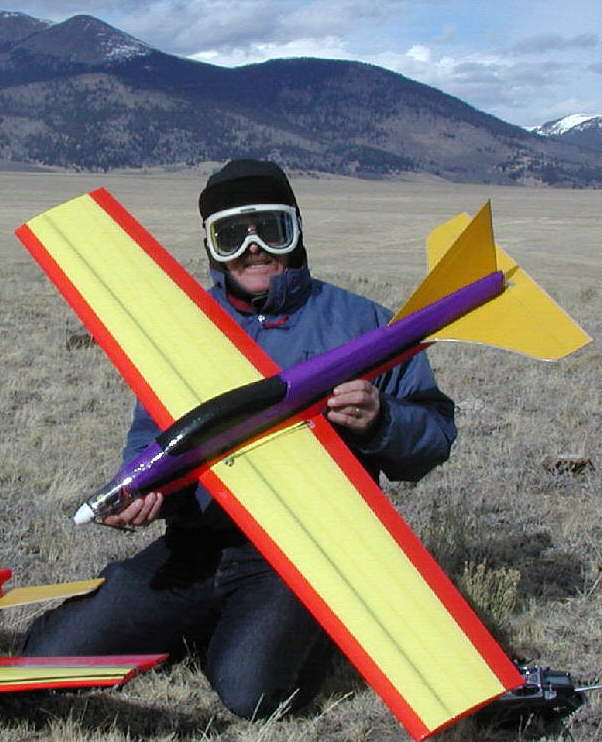

The Electra is handling very well on a 7 cell pack of the HE Cell 1800 4/5 A cells, flying a long can 550 ferrite motor and a CAM 9x5 folding prop; this is a lighter weight pack that can handle up to 26 Amps. These cells are available now for only $2.49 per cell . The GP 2000 4/5 A cells can handle well over 50 Amps... but they are a lot more pricey. Check CheapBatteryPacks.com for the latest in high performance NiMH batteries, as well as other batteries.
There's a new 4/5 Sub-C sized Gold Peak 2200 mAH NIMH VERY high current / very low internal cell resistance battery cell that's finally available; it's built similar to the GP 3300 Sub- C cells that perform so very well in the VIKING 60 running to 45 Amps, but weighs 43 grams per cell instead of 62 grams for the 3300s. They do cost $5.85 per cell, a bit pricey... I'll build up one 10 cell pack for my E-powered Spirit 100 full house sailplane that has the 20 sized cobalt motor in it. I am flying these cells in 7 cell packs in the Viento and Viking 60- they perform very well!
On this same page, the GP 2/3A sized 1100 mAH cells are also listed for $1.95 per cell; the exceptional thing is that these cells are designed to handle up to 30 Amps !!!!! - that's about twice what all of the other cells of this size / shape / capacity are designed to handle. (Lower internal cell resistance means higher RPM output from your motor / prop setup on a given cell count, and that's always nice.) For the WattAge 400 Cobalt motor, or the Multiplex Turbo 450 motor, both of which can use up into the 25 Amp range, these GP cells will handle the current & still be very light weight for their capacity. They will also hapilly recharge in a half hour or less, and keep on doing it for hundreds of flights.... I' fly these cells now in a couple of my aircraft.
The larger GP 3300 NiMH cells are only $4.50 per cell... a lot of performance for the money. Hopefully the GP 2200 cells will come down in price as they become more widely available; they seem to offer a nice compromise in capacity versus weight in a very high current cell.
The GP 3700 mAH Sub-C cells are only slightly heavier than the 3300 cells, and handle high currents very well.
[Gold Peak has simply left Sanyo behind in the dust when it comes to NiMH cell technology, from what I presently understand.....]
New NiMH batteryies are being made by INTELECT which are receiving good reviews and very good testing results. CBP is the source for all of these.
Oh, yes, LiPo batteries are lighter... but to run 40 to 45 Amps on a strong Cobalt Motor, they are still really pricey compared to the NiMH cells, & require more expensive speed controls with programmable cutoff voltage, and about an hour minimum recharge time... they are also more easily damaged & will fail if run at too high a discharge rate, and every now & then, one of them burns up dramaticly..... I do have quite a few smaller LiPoly packs now, and I will fly them in several of my small planes, but for the big electrics, I'm still an advocate & user of NiMH batteries.

Jump to the photo & information on my "LECTRA SPORT" on floats





Also, here is a page of photos and info on my 1/6 scale SIG J3 Cub, 'recomissioned' and now flying very impressively on an Astro Sport Cobalt 25 on 15 cells.




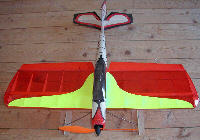

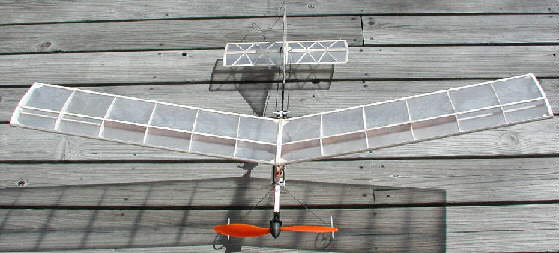
Wingspan 48 inches
Wing Area 345 square inches
Airfoil : Modified Eppler 205
Controls : Rudder & Elevator, Throttle
Weight: typically 7.75 ounces when flying with an 8 cell 300mAH NiMH battery, for a wing loading of 3.25 ounces per square foot
WHen flying with the 8 cell AAA 600 mAH NiMH battery pack, the weight is at 9.25 oynces, for a wing loading of 3.78 ounces per square foot. The larger capacity pack not only doubles flight time, but also increases RPM & available power- a nice trade for the extra 1.5 ounces weight!
For high altitude flying in the Central Colorado Rockies, (72% of the sea level air density at 10,000 feet) we're using the GWS 1080 Prop, which allows the LIGHT STIK B to fly at 50% to 60% throttle.
.180 diameter Carbon Fiber tubular fuselage used; .050 solid Carbon Fiber control rods
Easy to build, easy to fly! The wing and tail group are simple to build and cover, and yet quite strong. Handling is exceptional.

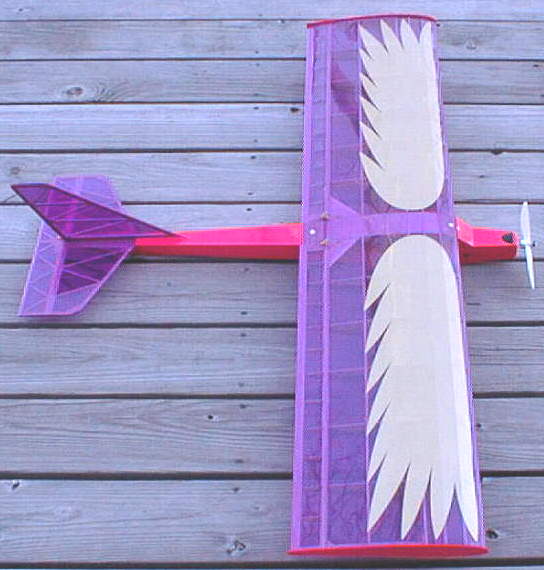
I was designing as a higher speed aerobatic aircraft, with an airfoil that would handle higher wind speeds and inverted flight well. I designed it for the MABUCHI FS-390 motor & Gunther 7x6 prop setup. Flying at 20.5 ounces on an 8 cell N-500A pack, this aircraft has once again exceeded my design expectations.

The vertical performance is impressive, while the landing characteristics are very predictable. It is, however, a 'neutral stability' design, being almost as happy upside down as right side up... It flies through outside loops from inverted flight easily! It's designed for just two servos, Elevator and Ailerons. The vertical stabilizer is fixed. While a rudder could also be easily added, it's a fine performer on just three channels. I'm flying it on an Airtronics Radiant transmitter, HITEC 555 mini receiver, and an SC6 high rate proportional electronic speed control with BEC (one of my own designs.)
It was built around an RG-15 airfoil, thickened to 10%, and modified with the ailerons. (This airfoil is used on a lot of high speed sailplane and Slope ship designs.) With 478 square inches of flying surface to this wing, the resulting wing loading is under 6.2 ounces per square foot. The possibilities as a powered slope flyer remain to be explored. It is very well behaved on landings, as should be expected at this wing loading.
Initial test flights were flown on Sunday, February 25th, 2001 over hay meadows close to home at 10,000 feet.





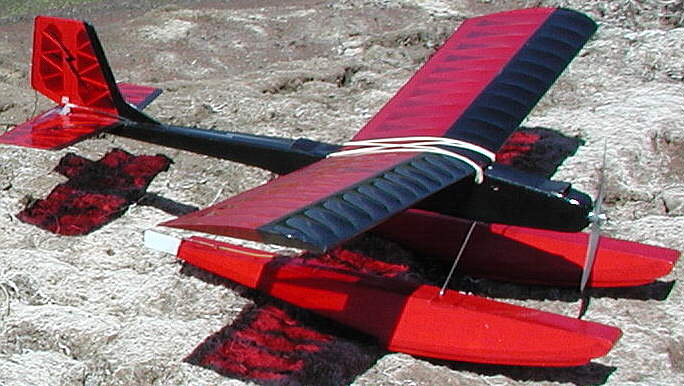
This "LECTRA SPORT" is not a 'new' design; I actually designed and built this electric aircraft in about 1986, so it's a veteran of many years of flying. It's wing uses a flat bottomed airfoil with a 50" wingspan, 9" chord, built using an aluminum arrow shaft leading edge, and built with angled wing tips. It currently flies with Rudder, Elevator, and Electronic throttle controls- (no ailerons were built into the original wing.) Fuselage length is about 37". The floats were built from a Mitch Poling design which was published in 'Model Builder' magazine back in the mid 1980s; they have a flat bottom wth a pronounced side angle. I added triangle rails on the forward hull outer edges, which really help to get this plane up on step & off the water quickly. It uses a single water rudder on the tail end of one float; early attempts to maneuver on the water in breezes without the water rudder were less than satisfactory...
It's currently flying with a Graupner "Speed 500 Race" can motor, using a 6 cell 3000mAH NiMH battery pack (from Radio Shack). The speed control is one of my SC6 designs. The prop I'm presently using with the 6 cell pack when flying from floats, at close to 10,000 feet altitude, is an APC 9x5 propeller (direct drive.)
Airframe weight with floats installed is 31-3/8 ounces. Flying weight with the 6 cell 3000mAH battery installed is just under 45 ounces. Wing loading with the heavy battery pack calculates out to just under 15 ounces per square foot.
This aircraft has been flown in the past with a 7 cell 800AR battery pack, for a lighter wing loading but shorter duration flights. I also now have a a couple of 8 cell Panasonic A size cell packs, which decrease the flying weight by another 5-3/8 ounces, allowing it to fly at around 39-1/2 ounces. It's flown from small lakes at up to 10,400 feet elevation so far, flying well. I'll fly it from one of the lakes above 12,000 feet one of these days.

For another aerobatic electric 400 size, simple to build. wood & covering kit, Tom Hunt's ELIPSTICK has been very favorably reviewed by an E-power flyer friend in Oregon. It looks fast to build, very light, and is said to perform very well! Info is available at MODELAIR-TECH : http://www.modelairtech.com/
All of Tom Hunt's kits & plans, as well as a wide variety of Electric Flight planes, kits, motors, props, etc. are available from NEW CREATIONS RC at http://www.newcreations-rc.com/
